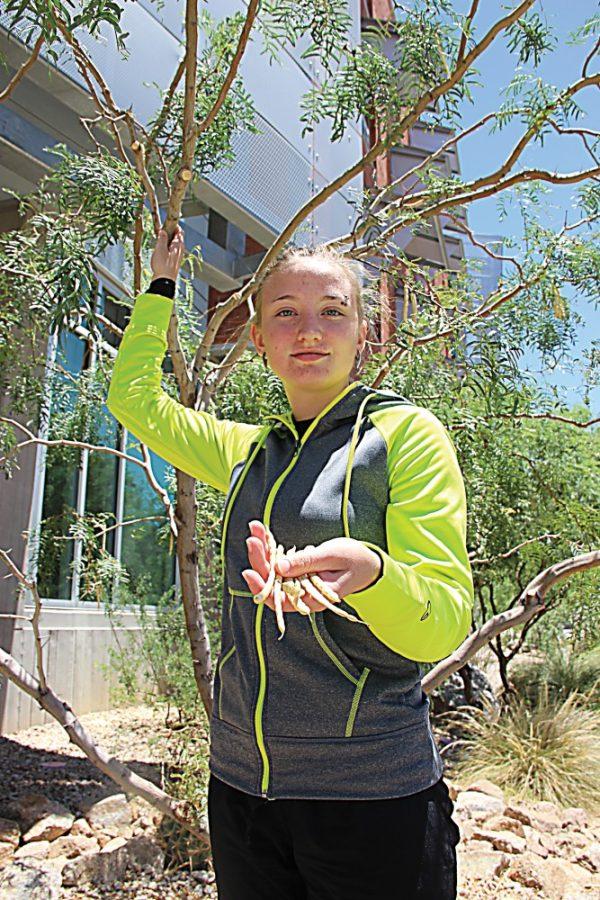The UA Campus Arboretum is working to promote sustainable practices and living, through several harvesting projects this summer and fall.
The arboretum is installing nets onto the trunks of mesquite trees to harvest the seed pods, which will be used to make flour.
Dining Services will incorporate the mesquite flour into several dishes served on campus, and olives and citrus fruit will also be harvested in similar projects.
“As a land-grant school, our three-fold mission is research, education and outreach, so I think it’s really appropriate that we have the campus itself designated as an arboretum,” said Tanya Quist, assistant professor of plant science and director of the Campus Arboretum.
The arboretum is also interested in promoting sustainability related initiatives, Quist said. To that end, they have given the green light to several fruit-harvesting projects on campus.
“To me, sustainability is balancing inputs and outputs,” Quist said.
In terms of the mesquite trees, Quist said the input is the work that goes into maintaining the trees, and the output includes shade, aesthetic appeal and floodwater absorption.
“So, harvesting the products of these trees increases the outputs that they are providing,” she said.
The mesquite harvesting project is supported by the UA Green Fund, which provides grant money for projects aimed at making the university more environmentally sustainable. Maya Cross-Killingsworth, a microbiology sophomore and an intern with the Office of Sustainability, is coordinating the mesquite project.
“It’s nice to know that, really, the campus is a garden, and that there’s a lot of edible food here,” Cross-Killingsworth said.
The mesquite pods will be collected via a “passive harvesting” system that catches the pods that fall off the tree in a net affixed to its base. Designed by a UA student, the nets are intended to streamline the harvesting process, which was previously done by hand.
The mesquite seed pods are highly nutritious, Cross-Killingsworth said. However, the only readily edible part of the pod is the spongy pith that lies between the rigid outer skin and the hard seeds. A milling process is therefore necessary to transform the pods into flour.
“It’s a sort of sweet-tasting flour,” Cross-Killingsworth said, “So it’s best for things like pancakes, brownies and pastries.”
In 2011, the Office of Sustainability worked with Dining Services to add flour made from UA-harvested mesquite to campus menus, said Joe Abraham, director of the Office of Sustainability.
Abraham said that it was a complicated process due to liability issues.
“It’s one thing to have someone dump a bunch of food products on your dock that come from companies that are regulated. It’s another thing to produce some flour that comes off a tree,” Abraham said. “Working through all those little details was a process, but we’ve worked through all that.”
The Office of Sustainability will work with LEAF, which stands for Linking Edible Arizona Forests, to coordinate citrus and olive harvests later in the year, said Melanie Lenart, project manager of LEAF on the UA campus.
In collaboration with the Iskashitaa Refugee Network, various types of limes, oranges and grapefruits will be harvested and distributed to local refugees. Iskashitaa is a local organization that engages the community in harvesting fruits and vegetables that would otherwise go to waste, said Barbara Eisworth executive director of Iskashitaa.
“We feed families instead of landfills,” Lenart said.
According to Quist, the university has served the purposes of an arboretum since it first opened its doors in 1885.
“Our campus grounds themselves have always been used as a living laboratory,” she said.
In fact, Quist said, many of the olive trees on the west side of campus were planted over 120 years ago by Robert Forbes, for whom the agriculture building is named.
While the olive trees were planted to determine the viability of different varieties for use in the desert, the trees will now be harvested to promote sustainability in an urban environment, Quist said.
“The goal arboretum is primarily to promote stewardship of urban trees,” Quist said. “But more broadly, the emphasis is to promote sustainable practices and sustainable living in the desert.”









